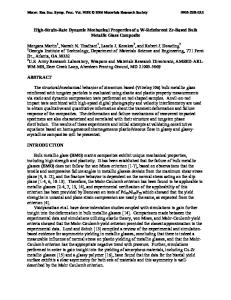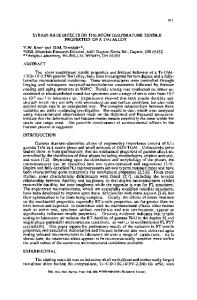Investigations of Strain Rate Effects on the Mechanical Properties of Hybrid Composite Laminate Under Varying Temperatur
- PDF / 3,042,652 Bytes
- 16 Pages / 595.276 x 790.866 pts Page_size
- 7 Downloads / 382 Views
RESEARCH ARTICLE-MECHANICAL ENGINEERING
Investigations of Strain Rate Effects on the Mechanical Properties of Hybrid Composite Laminate Under Varying Temperatures Engin Erbayrak1
· Beril Eker Gumus2 · Ercument Ugur Yuncuoglu2 · Yusuf Kahraman2
Received: 19 February 2020 / Accepted: 19 August 2020 © King Fahd University of Petroleum & Minerals 2020
Abstract The mechanical behavior of hybrid composite laminates under varying strain rates and temperatures was investigated in this study. The hybrid composite laminate is constituted as a sequential stacking sequence of plain-woven carbon-fiber-reinforced epoxy (CFRE) and plain-woven glass-fiber-reinforced epoxy (GFRE) laminates. Vacuum-assisted resin transfer molding (VARTM) process was used to fabricate the composite laminates. Hybrid composite laminates (HCGFRE) were tested under four different strain rates (0.05 min−1 , 0.5 min−1 , 2.5 min−1 , 5 min−1 ) and three different temperatures (RT, 60 °C, 100 °C). Microstructure analysis was performed to observe the voids, fiber delamination and matrix failure occurring in the composite laminate. In numerical analyses, continuum damage mechanics material model (MAT 58) was utilized in LS-DYNA® explicit finite element program to simulate the mechanical properties of CFRE, GFRE and HCGFRE laminates. It was determined that the tensile strength of all composite laminates is increasing by increasing the strain rates in all temperatures. The continuous damage mechanics material model (MAT 58) was found to be suitable for simulating woven composite laminate under different strain rates and temperatures. In microstructural study, it was not observed significant changes in the microstructure of composite laminates by changing strain rates. Keywords Hybrid composite · Strain rates · Varying temperatures · VARTM · Continuum damage mechanics material model
1 Introduction Recently, composite materials are often preferred compared to other materials due to their mechanical and physical properties such as lightness, high strength and good conductivity. Also, they have been utilized where corrosion resistance, low cost and ease of production are required. Composite materials are renewed with developing technology. Hybrid composite technology stands out as the first in this innovation. In the literature, the determination of the mechanical properties of hybrid composite materials formed from different fiber and matrix components exists [1–5]. However, the determination of the mechanical properties of hybrid composite laminates under different strain rates and temperatures is highly limited in the literature. Moreover, the numerical study of HCFGRE composite laminate using continuous damage mechanics law (MAT 58) was not encountered.
B
Engin Erbayrak [email protected]
1
Bayburt University, Bayburt, Turkey
2
Yıldız Technıcal University, Istanbul, Turkey
Elanchezhian et al. [6] investigated mechanical behavior of glass- and carbon-fiber-reinforced composites under different strain rates and temperatures. They determined t
Data Loading...











